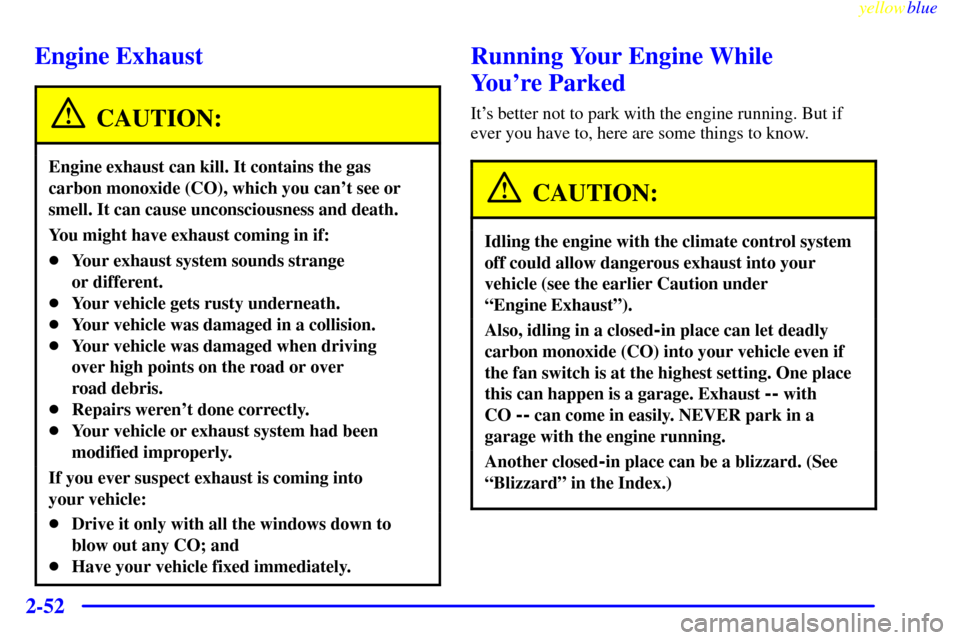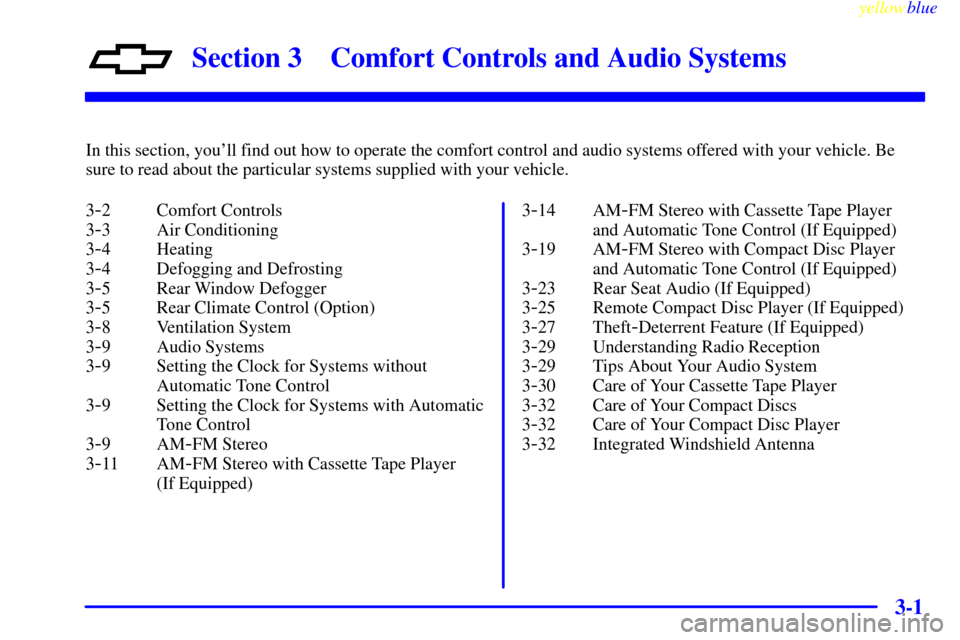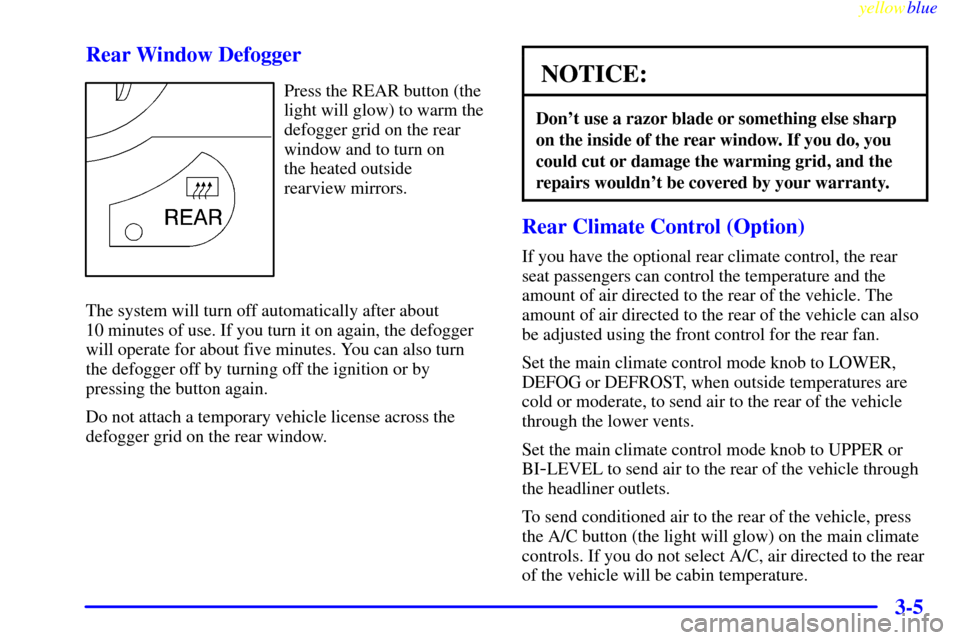Page 112 of 440

yellowblue
2-12Switchbanks
There are two sets of switchbanks located in the front of the
vehicle. The switches will vary with the options that are on
your vehicle. It is useful to become familiar with them since
they are used frequently while operating the vehicle.
Overhead Console Switchbank
This switchbank is located in the overhead console. The
switches that you may find in this switchbank are the
Interior Lights Override, Power Sliding Door and the
Power Rear Quarter Windows. If your vehicle does not
have some of the options controlled by these switches,
there will be a blank button in its place.
For more information, please see each of these features
in the Index.
Instrument Panel Switchbank
This switchbank is located in the instrument panel below
the comfort controls. The switches and controls that you
may find in this switchbank are the Rear Fan Knob,
Rear Window Wiper/Washer and Traction Control. If
your vehicle does not have some of the options
controlled by these switches, there will be a blank button
in its place.
For more information, please see each of these features
in the Index.
If your vehicle is not equipped with the optional rear
climate control system, there will be a storage space in
this switchbank. The rubber mat can be removed for
cleaning. Snap the mat into place after cleaning.
Page 152 of 440

yellowblue
2-52
Engine Exhaust
CAUTION:
Engine exhaust can kill. It contains the gas
carbon monoxide (CO), which you can't see or
smell. It can cause unconsciousness and death.
You might have exhaust coming in if:
�Your exhaust system sounds strange
or different.
�Your vehicle gets rusty underneath.
�Your vehicle was damaged in a collision.
�Your vehicle was damaged when driving
over high points on the road or over
road debris.
�Repairs weren't done correctly.
�Your vehicle or exhaust system had been
modified improperly.
If you ever suspect exhaust is coming into
your vehicle:
�Drive it only with all the windows down to
blow out any CO; and
�Have your vehicle fixed immediately.
Running Your Engine While
You're Parked
It's better not to park with the engine running. But if
ever you have to, here are some things to know.
CAUTION:
Idling the engine with the climate control system
off could allow dangerous exhaust into your
vehicle (see the earlier Caution under
ªEngine Exhaustº).
Also, idling in a closed-in place can let deadly
carbon monoxide (CO) into your vehicle even if
the fan switch is at the highest setting. One place
this can happen is a garage. Exhaust
-- with
CO
-- can come in easily. NEVER park in a
garage with the engine running.
Another closed-in place can be a blizzard. (See
ªBlizzardº in the Index.)
Page 185 of 440
yellowblue
2-85
The main components of the instrument panel are:
A. Side Vents
B. Front Vents
C. Turn Signal/Multifunction Lever
D. Hazard Warning Flashers Switch
E. Instrument Panel Cluster
F. Center Vents
G. Audio System
H. Side Vents
I. Lamp Switch
J. Hood Release
K. HornL. Ignition Switch
M. Climate Controls
N. Rear Fan Controls (Option)
O. Accessory Power Outlet
P. Storage Bin
Q. Remote CD Player (Option)
R. Instrument Panel Switchbank
S. Ashtray and Cigarette Lighter
T. Glove Box
U. Front Vents
V. Instrument Panel Fuse Block
Page 205 of 440

3-
yellowblue
3-1
Section 3 Comfort Controls and Audio Systems
In this section, you'll find out how to operate the comfort control and audio systems offered with your vehicle. Be
sure to read about the particular systems supplied with your vehicle.
3
-2 Comfort Controls
3
-3 Air Conditioning
3
-4 Heating
3
-4 Defogging and Defrosting
3
-5 Rear Window Defogger
3
-5 Rear Climate Control (Option)
3
-8 Ventilation System
3
-9 Audio Systems
3
-9 Setting the Clock for Systems without
Automatic Tone Control
3
-9 Setting the Clock for Systems with Automatic
Tone Control
3
-9AM-FM Stereo
3
-11 AM-FM Stereo with Cassette Tape Player
(If Equipped)3
-14 AM-FM Stereo with Cassette Tape Player
and Automatic Tone Control (If Equipped)
3
-19 AM-FM Stereo with Compact Disc Player
and Automatic Tone Control (If Equipped)
3
-23 Rear Seat Audio (If Equipped)
3
-25 Remote Compact Disc Player (If Equipped)
3
-27 Theft-Deterrent Feature (If Equipped)
3
-29 Understanding Radio Reception
3
-29 Tips About Your Audio System
3
-30 Care of Your Cassette Tape Player
3
-32 Care of Your Compact Discs
3
-32 Care of Your Compact Disc Player
3
-32 Integrated Windshield Antenna
Page 209 of 440

yellowblue
3-5 Rear Window Defogger
Press the REAR button (the
light will glow) to warm the
defogger grid on the rear
window and to turn on
the heated outside
rearview mirrors.
The system will turn off automatically after about
10 minutes of use. If you turn it on again, the defogger
will operate for about five minutes. You can also turn
the defogger off by turning off the ignition or by
pressing the button again.
Do not attach a temporary vehicle license across the
defogger grid on the rear window.NOTICE:
Don't use a razor blade or something else sharp
on the inside of the rear window. If you do, you
could cut or damage the warming grid, and the
repairs wouldn't be covered by your warranty.
Rear Climate Control (Option)
If you have the optional rear climate control, the rear
seat passengers can control the temperature and the
amount of air directed to the rear of the vehicle. The
amount of air directed to the rear of the vehicle can also
be adjusted using the front control for the rear fan.
Set the main climate control mode knob to LOWER,
DEFOG or DEFROST, when outside temperatures are
cold or moderate, to send air to the rear of the vehicle
through the lower vents.
Set the main climate control mode knob to UPPER or
BI
-LEVEL to send air to the rear of the vehicle through
the headliner outlets.
To send conditioned air to the rear of the vehicle, press
the A/C button (the light will glow) on the main climate
controls. If you do not select A/C, air directed to the rear
of the vehicle will be cabin temperature.
Page 210 of 440
yellowblue
3-6
Rear Fan Control
This option comes with the rear climate controls.
Keep the area around the base of the center instrument
panel console and the area between and under the front
seats free of objects that would obstruct airflow to the
rear of the vehicle.
The rear fan control is
located below the climate
control system, in
the switchbank.
Turn the fan to the desired setting for the amount of air
to be directed to the rear of the vehicle. The temperature
of the air will be the same as the air in the front of the
vehicle. The rear fan control in the instrument panel
switchbank has an R setting which allows the rear
passengers to use the rear climate control knobs to
adjust the air through the rear air outlets.Rear Comfort Controls
The rear climate control knobs are in a panel next to the
second row seat. If your vehicle has the optional dual
sliding doors, the panel is above the driver's seat.
Page 211 of 440
yellowblue
3-7
Turn the temperature knob counterclockwise (to the blue
area) for cooler air, or clockwise (to the red area) for
warmer air.
To maintain a comfortable temperature in the rear, use
either rear fan control to adjust the force of air coming
through the rear outlets.
Select the desired climate control mode using the
directional controls on the instrument panel (see ªMode
Knobº earlier in this section). The mode you choose will
regulate both the front and rear climate control systems.Rear Air Vents
To maximize airflow through the rear heater outlet,
place the left bucket seat in the second row in the
forward position (see ªAdjusting Rear Seatsº in
the Index).
The vent behind the left rear seat is the cold air return
vent. Be sure to keep it free of obstructions.
Keep the area around the base of the center instrument
panel console and between and under the front seats free
of objects that could obstruct airflow to the rear.
Page 354 of 440

yellowblue
6-44 Uniform Tire Quality Grading
The following information relates to the system
developed by the United States National Highway
Traffic Safety Administration, which grades tires by
treadwear, traction and temperature performance. (This
applies only to vehicles sold in the United States.) The
grades are molded on the sidewalls of most passenger
car tires. The Uniform Tire Quality Grading system does
not apply to deep tread, winter
-type snow tires,
space
-saver or temporary use spare tires, tires with
nominal rim diameters of 10 to 12 inches (25 to 30 cm),
or to some limited
-production tires.
While the tires available on General Motors passenger
cars and light trucks may vary with respect to these
grades, they must also conform to Federal safety
requirements and additional General Motors Tire
Performance Criteria (TPC) standards.Treadwear
The treadwear grade is a comparative rating based on
the wear rate of the tire when tested under controlled
conditions on a specified government test course. For
example, a tire graded 150 would wear one and a half
(1 1/2) times as well on the government course as a tire
graded 100. The relative performance of tires depends
upon the actual conditions of their use, however, and
may depart significantly from the norm due to variations
in driving habits, service practices and differences in
road characteristics and climate.
Traction -- AA, A, B, C
The traction grades, from highest to lowest, are AA, A,
B, and C. Those grades represent the tire's ability to stop
on wet pavement as measured under controlled
conditions on specified government test surfaces of
asphalt and concrete. A tire marked C may have poor
traction performance. Warning: The traction grade
assigned to this tire is based on straight
-ahead braking
traction tests, and does not include acceleration,
cornering, hydroplaning, or peak traction characteristics.